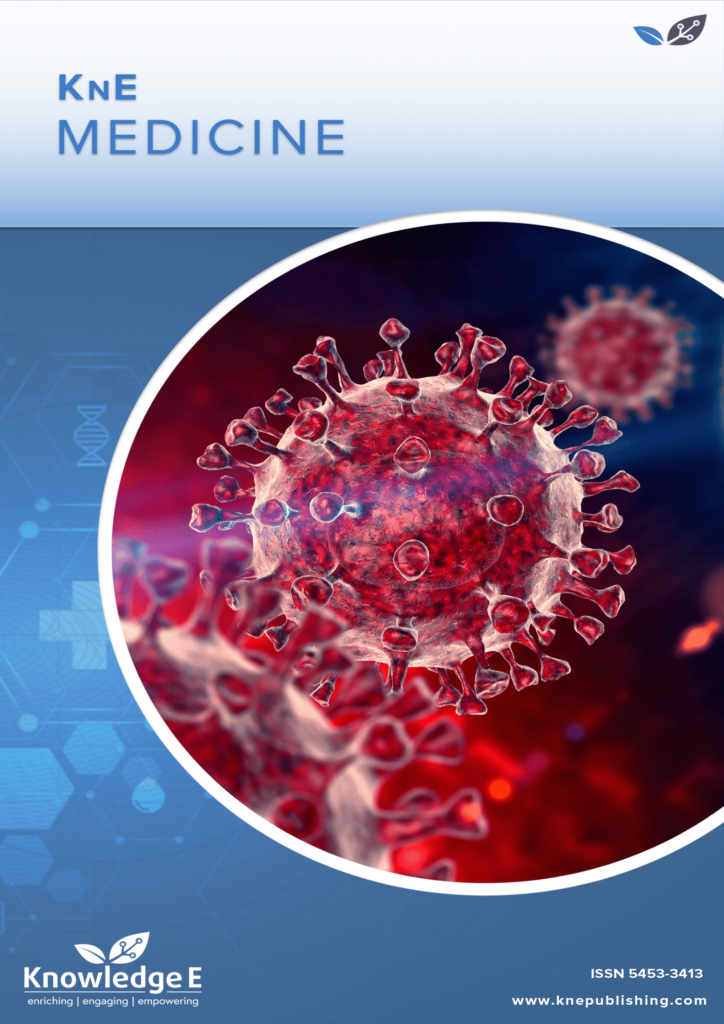
KnE Medicine
ISSN: 2519-125X
The latest conference proceedings on all fields of medicine.
Melinjo (Gnetum Gnemon) Seed Protein Activity Against pBSKS DNA Cleavage and Its Cytotoxicity in T47D and 4T1 Cells
Published date: Sep 15 2022
Journal Title: KnE Medicine
Issue title: The International Conference of Medicine and Health (ICMEDH)
Pages: 517–533
Authors:
Abstract:
The plant protein of melinjo (Gnetum gnemon) in seeds is known to have antioxidant properties. Apart from being an antioxidant, melinjo seed protein also has the potential to be developed as an anticancer compound. One of the potential anticancer compounds has been screened based on supercoiled DNA cleavage activity (pBSKS). The purpose of this study was to determine the activity of the protein fraction isolated with DEAE and BUTYL matrices against supercoiled DNA cleavage of pBSKS. Supercoiled DNA cleavage test activity of pBSKS was determined using the electrophoresis method and visualized with a UV transilluminator at a wavelength of 312 nm. The cytotoxic activity of melinjo seeds was tested through the MTT assay method and was read on an ELISA reader with a wavelength of 550 and 595 nm seen from the IC50 value. The protein fraction of melinjo seeds isolated with DEAE and BUTYL matrices had concentrations of 470.1 and 81.02 g/mL, respectively. The visualization results showed that the DEAE and BUTYL protein fractions resulted in depletion of supercoiled DNA bands of pBSKS. The concentration of active protein in the melinjo seeds fractionated using the DEAE-650M matrix was higher than that of the BUTYL-650M matrix. In this study, after several cytotoxic tests were carried out, various results were obtained. The activity of protein isolates from melinjo seeds fractionated using DEAE-650M and BUTYL-650M against 4T1 and T47D cells could be categorized as non-toxic because the IC50 value was > 1000 g/mL and the average percentage of viable cells was more than 50%, except for the seed protein fraction. Melinjo fractionated using DEAE-650M against T47D cells which had an IC50 value of 127.62 g/mL could be categorized as quite active and cytotoxic.
Keywords: Gnetum gnemon L., protein isolation, ribosome-inactivating proteins (RIPs), DNA cleavage, cytotoxic, T47D, 4T1
References:
[1] Bray F, Ferlay J, Soerjomataram I, Siegel RL, Torre LA, Jemal A. Global cancer statistics 2018: GLOBOCAN estimates of incidence and mortality worldwide for 36 cancers in 185 countries. CA: A Cancer Journal for Clinicians. 2018 Nov;68(6):394– 424.
[2] Ministry of Health of Indonesia. Riset Kesehatan Dasar (RISKESDAS) 2013, Balitbangkes Kemenkes RI, Jakarta. 2014.
[3] Ministry of Health of Indonesia. Riset Kesehatan Dasar (RISKESDAS) 2018, Balitbangkes Kemenkes RI, Jakarta. 2019.
[4] Pizzo E, Di Maro A. A new age for biomedical applications of Ribosome Inactivating Proteins (RIPs): from bioconjugate to nanoconstructs. Journal of Biomedical Science. 2016;23(1):54.
[5] Burger K, Mu B, Harasim T, Rohrmoser M, Malamoussi A, Orban M, et al. Chemotherapeutic Drugs Inhibit Ribosome Biogenesis at Various Levels * . 2010;285(16):12416–25.
[6] Siswoyo TA, Mardiana E, Lee KO, Hoshokawa K. Isolation and characterization of antioxidant protein fractions from melinjo (Gnetum gnemon) seeds. Journal of Agricultural and Food Chemistry. 2011 May 25;59(10):5648–56.
[7] Lopaczynski W, Zeisel SH. Antioxidants, programmed cell death, and cancer. 2001.
[8] Narayanan S, Surendranath K, Bora N, Surolia A, Karande AA. Ribosome inactivating proteins and apoptosis. FEBS Letters. 2005;579(6):1324–31.
[9] Sambrook, J. FEF and MT. Molecular Cloning: A Laboratory Manual, Cold Spring Harbor Lab press, United States of America. 1989.
[10] CCRC. Prosedur Tetap Uji Sitotoksik Metode MTT, Fakultas Farmasi Universitas Gadjah Mada, Yogyakarta. 2009.
[11] H.M E. Enzymology Primer for Recombinant DNA Technology, Academic Press, London. 1996.
[12] T.A B. Gene Cloning and DNA Analysis: An Introduction, 5th ed., Blackwell Publishing, United Kingdom. 2006.
[13] Teare JM, Islam R, Flanagan R, Gallagher S, Davies MG, Grabau C, et al. Measurement of Nucleic Acid Concentrations Using the DyNA Quant TM and the GeneQuant TM. 1997;1170–4.
[14] Ahmed H. Principles and reactions of Protein Extraction, Purification, and Characterization. Florida: CRC Press; 2000.
[15] McCue JT. Chapter 25 Theory and Use of Hydrophobic Interaction Chromatography in Protein Purification Applications. In: Burgess RR, Deutscher MPBTM in E, editors. Guide to Protein Purification, 2nd Edition. Academic Press; 2009. p. 405–14.
[16] Indrayudha P, Rosyid Thoyib Wijaya A, Iravati S. Uji Aktivitas Ekstrak Daun Dewandaru dan Daun Keladi Tikus Terhadap Pemotongan DNA Superkoil Untai Ganda. Jurnal Farmasi Indonesia. 2006;3(2):63–70.
[17] CCRC. Prosedur Tetap Uji Sitotoksik Metode MTT. CCRC Fakultas Farmasi UGM. CCRC UGM; 2012.
[18] Anggrianti P. Uji Sitotoksik Ekstrak Etanol 70% Buah Kemukus (Piper cubeba) Terhadap Sel HeLa. Fakultas Farmasi, Universitas Muhammadiyah Surakarta, Surakarta. 2008;
[19] Prayong P, Barusrux S, Weerapreeyakul N. Cytotoxic activity screening of some indigenous Thai plants. Fitoterapia. 2008;79(7):598–601.